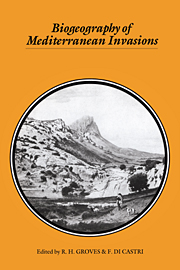Book contents
- Frontmatter
- Contents
- List of contributors
- Preface
- Part I Introduction
- Part II Historical background
- 2 The palaeohistory of the Mediterranean biota
- 3 Human impact on the biota of mediterranean-climate regions of Chile and California
- 4 Central Chile: how do introduced plants and animals fit into the landscape?
- 5 Historical background of invasions in the mediterranean region of southern Africa
- 6 A short history of biological invasions of Australia
- Part III Biogeography of taxa
- Part IV Applied aspects of mediterranean invasions
- Part V Overview
- Index of scientific names
- Subject index
2 - The palaeohistory of the Mediterranean biota
Published online by Cambridge University Press: 02 December 2009
- Frontmatter
- Contents
- List of contributors
- Preface
- Part I Introduction
- Part II Historical background
- 2 The palaeohistory of the Mediterranean biota
- 3 Human impact on the biota of mediterranean-climate regions of Chile and California
- 4 Central Chile: how do introduced plants and animals fit into the landscape?
- 5 Historical background of invasions in the mediterranean region of southern Africa
- 6 A short history of biological invasions of Australia
- Part III Biogeography of taxa
- Part IV Applied aspects of mediterranean invasions
- Part V Overview
- Index of scientific names
- Subject index
Summary
The historical background to invasions in the Mediterranean Basin is an integral part of the evolution of the region's natural and cultural landscapes. Vegetation changes were induced by a combination of climatic stress, natural and constant human disturbances and a resulting resilience to invasion. Recently, the problems of human impact on Mediterranean vegetation have been discussed in detail (see, e.g. Le Houérou, 1981; Pignatti, 1983; Pons & Quézel, 1985; Vernet & Thiébault, 1987; Naveh & Kutiel, 1990). In this chapter we shall describe, briefly, the natural and cultural processes which shaped the Mediterranean landscapes from the Pleistocene onwards. We shall then present some of the archaeobotanical evidence for evolutionary and historical changes in the vegetation.
The evolution of natural and semi-natural Mediterranean landscapes in the Pleistocene
The landscapes of the Mediterranean Basin are relatively young geological systems; they gained their present geomorphological forms by violent uplift in the late Tertiary and early Quaternary periods (di Castri & Mooney, 1973; di Castri et al., 1981). Final shaping of the landscapes took place in the Pleistocene in a highly dynamic period of climatic fluctuations, and tectonic and volcanic activity. Site conditions, both physical and biological, diversified increasingly. From the Middle Pleistocene onwards, early Mediterranean peoples further diversified these landscapes on both a regional and local scale, thereby contributing to their present multi-dimensional heterogeneity (di Castri, 1981).
- Type
- Chapter
- Information
- Biogeography of Mediterranean Invasions , pp. 19 - 32Publisher: Cambridge University PressPrint publication year: 1991
- 17
- Cited by

